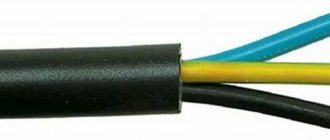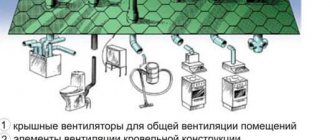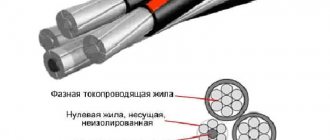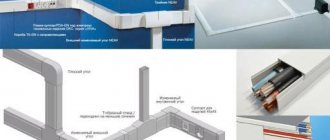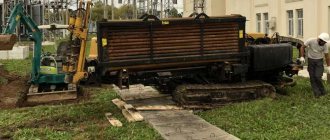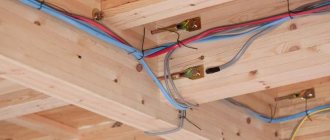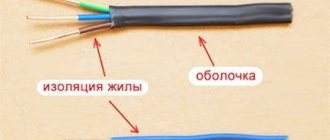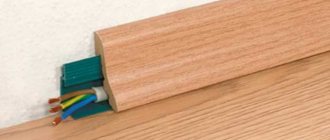Just as a dacha differs from a city apartment, the installation of electrical wiring in a dacha has its own characteristics. In rural areas, electricity is supplied through overhead lines. More frequent storms lead to downed wires. This in turn causes voltage surges that require additional protection against electric shock.
Sometimes dachas are located “on the outskirts”, at a distance from 220-380 V lines. But nearby there may be a high-voltage rural power line with a voltage of 6 (10) kV. They usually walk along roads from village to village. Then a step-down transformer is required for the electrical wiring.
Important nuances when laying country wiring
When planning the installation of electrical conductors in a suburban area, you should decide on the scope of work. A full replacement or restoration of the existing network can be carried out. In any case, it is recommended to follow the following rules:
- Distribution boxes, electricity meter, switches and sockets should be located in easily accessible places.
- Switches must be installed so that they are not blocked when the door leaf is opened. Switches are installed at a height ranging from 60 to 150 cm.
- Sockets are installed at a sufficient distance from the water supply system and heating devices at a height of at least 50 cm from the floor.
- Power wires to sockets are supplied from bottom to top, and to switches - from top to bottom.
- Direct connections of copper and aluminum conductors are not allowed.
- It is necessary to exclude the location of sockets in rooms with high humidity (bathrooms and restrooms);
- The wiring must be laid according to the prepared diagram, which is recommended to be saved.
Placing distribution boxes in a wooden house
All work is carried out in compliance with safety precautions.
How to submit a list of documents and an application to an energy sales company
Documents are sent to the company by mail or courier. The processing time for the received application is 30 days, during which the applicant receives an agreement for connection to SNT with signatures of authorized persons.
The recipient must respond to the letter within a month. If the client refuses to provide services, he must justify the decision.
Problems caused by the location of the summer cottage
Most holiday villages are located outside the city. At the same time, old power lines are usually used to power them. They are not designed to withstand large flows of electrical energy that arise due to the use of a variety of household appliances. This is accompanied by periodic interruptions in electrical networks, which can lead to failure of equipment installed at the dacha. To eliminate this problem, you will need to use highly sensitive circuit breakers and voltage stabilizers.
Voltage stabilizer for a private home
The condition of the wiring of a summer cottage is strongly influenced by the frequency of stay in it. This fact must be taken into account when choosing a wiring method, since without heating in winter, moisture will accumulate inside the room. Oxidation of the contact connections will gradually occur, which will lead to a short circuit, and as a result, the need for restoration work.
Important! Taking into account the fact that the dacha plot is private property, the owners must take care of the installation of the grounding loop and lightning rod themselves.
Electrical requirements
Devices used to electrify the site must comply with safety standards.
To the counters
Technical means of electricity metering installed in summer cottages must comply with GOST 6570-96. The current strength of the meter for residential premises is 30 A, accuracy class - 2. These requirements are taken into account when purchasing the device. 50 A devices are intended for private houses and cottages. The phase pattern of the electrical network is considered an important criterion.
To the Verkhovna Rada
The device is a switchboard with a set of equipment necessary for managing electrical networks, protecting against voltage surges and increased loads. The ASU includes an input cable, emergency shutdown systems, RCD, and grounding.
What type of wiring to use at the dacha
To determine the best option, you should familiarize yourself with each of them separately. At the dacha you can use open and closed wiring. Each option has its own pros and cons that must be taken into account for the final choice. There are also differences in installation.
Open gasket
This option involves an open arrangement of cable lines (CL) directly on the walls of the dacha, including on top of finishing materials. Special protective boxes can be used, which are made in different colors. This will allow you to match the elements to the color of the design. The main advantage of open wiring is quick installation. There is also the possibility of trouble-free troubleshooting and installation of additional power points.
Open wiring in cable channels
The only negative point is the aesthetic side. All installed wiring is visually accessible, which some owners of country estates may not like.
It is rational to use open wiring in dachas that are used exclusively in the summer.
Hidden gasket
It is impossible to use this wiring option in dachas with wooden walls without finishing. Closed wiring involves laying cables in grooves, which are subsequently hidden under a layer of plaster. This will require more time and effort, but you will be able to achieve an aesthetic appearance.
Closed wiring is accompanied by increased safety. But in case of damage to individual supply cores, it is necessary to remove the finishing layer.
Hidden electrical wiring device
Preparing the wiring diagram
To draw up a power distribution diagram at your dacha, you can use two options:
- classic - using a regular pencil and paper;
- modern - using specialized computer programs.
When performing work, it is not necessary to comply with established norms and rules. It is enough to accurately display the installation locations of switches, sockets, lamps, equipment, junction boxes, as well as the location of cable lines. It is first recommended to draw a schematic plan of a country house.
Electrical wiring diagram in a country house
Briefly about the main thing
Underground cable laying eliminates accidental breakage and electric shock to people. Despite the need to perform excavation work, this method is considered more preferable, since there is usually no need to maintain or repair the wires.
Before laying a wire underground at the dacha, you should draw up a working drawing where the route will be marked in compliance with all permissible distances and gaps
In addition, it is important to maintain the specified trench depth and avoid sharp turns
Only suitable grades of conductor should be used and the correct cross-section should be ensured. Power should be calculated with a margin, since the load may increase.
Determination of design loads
After drawing up a preliminary wiring diagram for a suburban estate, you should begin calculating the load. To do this, you will need to take into account the power of all electrical appliances, as well as lighting lamps. To minimize costs for cable lines, it is recommended to divide electricity consumers into several groups. The formation of groups is carried out taking into account the location and type of equipment.
With the correct calculation of the loads, it will be possible to avoid current overloads of the cable cores, and, accordingly, damage.
Load distribution among consumer groups
Selection of the required cable cross-section
After determining the loads of all supply lines, you can begin to select the cross-section of the current-carrying conductors. To do this, it is necessary to divide the calculated rated power by the network voltage, which will determine the current value. Based on the obtained value, the cable line section is selected using tables PUE 1.3.4 and 1.3.5. Using the first, conductors with aluminum conductors are selected, and the second, with copper conductors.
Table PUE 1.3.5 permissible cable currents
The required length of the conductors can be approximately determined from a previously prepared diagram.
The cost of conducting electricity in SNT
The price of the service throughout Russia is 550 rubles. for all clients. The tariff includes the standard procedure for connecting to the public network. The price may increase if more than 15 kW is allocated to each SNT participant.
Connection conditions:
- filing an application;
- the owner undertakes not to use electricity for production activities;
- maintaining a distance from the first line to the subscriber of 300 m for villages and 500 m for rural areas;
- 1 power supply;
- the total power of devices in the territory is less than 15 kW;
- The first application to connect the site in 3 years.
The network organization does not have the right to charge additional fees for laying an electrical network, installing a transformer substations and issuing related documentation. The subscriber deposits money only at the established federal tariff.
Options for supplying power cables from power lines
In the process of installing electrical wiring at the dacha, the owner will certainly be faced with the question of how to connect the power supply to the household. The cable line will need to be pulled from the nearest overhead power line support, naturally after obtaining the necessary permits, together with representatives of electrical network services. You can use one of the following options for connecting to a power line support:
- by air;
- underground.
Supplying a cable to a country house by air
Next, we will consider in detail the advantages, disadvantages, as well as important installation nuances for each of the options.
Air supply
Supplying power to a country house by air can be done using two methods. The first involves the use of SIP cable, which means self-supporting insulated wire. It stretches directly from the power line to the facade of the house. The second option is accompanied by pre-tensioning of the metal cable from the support of the centralized electrical network to the walls of the house using special hooks or talpers. This allows you to use any cable cables that are subsequently fixed to the cable.
Regardless of the chosen method, you will need to use additional insulating fasteners to secure the conductive wires. The following factors will need to be taken into account:
- If the distance from the power line support to the construction site is more than 25 meters, intermediate support pillars should be installed.
- In winter, the load on the wires will increase due to the accumulation of ice. In this regard, it is necessary to correctly calculate the load-bearing capacity of the cable.
- Ultraviolet radiation contributes to the mechanical destruction of the insulating layer of conductor cores. Therefore, it is necessary to use additional protection in the form of corrugation.
Standards for connecting a house to a power line
Connecting electricity to a country house from a pole via air is carried out in the shortest possible time. You will need to purchase special fasteners and also use a tower. This comes with additional costs.
Power supply underground
When powering a country home with a cable laid underground, it is recommended to adhere to the following rules:
- The wires are laid in a trench at least seventy centimeters deep. Except for the case when the cable line is laid in a protective pipe, and the length from the power line support to the input panel is less than five meters. Under such conditions, it is possible to prepare a trench 50 cm deep.
- The trench must be dug at a distance of at least 60 cm from the foundation. If there is a need to lay a cable through the foundation, then you will need to use an additional pipe in it. It is prohibited to pull conductive conductors directly under the foundation.
- When excavating a trench, the following distances should be maintained from various objects:
- 75 cm - bush plantings;
- 100 cm - sewerage, water supply;
- 200 cm - trees, gas pipeline.
- The cable must be armored and have appropriate insulation protection.
Supplying electricity to the house underground
The listed instructions are determined by the requirements of the PUE, PTE and SNiP, regardless of the selected cross-section of the current-carrying conductors.
The main advantage of this option for connecting a country house to a centralized power supply is the minimal cost of the required material. You can also do without using special equipment. Laying the power cable underground will be difficult if the area is tiled or concrete is poured.
Advantages of connecting electricity to SNT
Individual connection to networks is due to 3 advantages:
- Outdated equipment. During operation, it loses its properties, which is why the actual power is several times lower than the standard value.
- Availability of debtors. When SNT has members who do not pay their electricity bills, the remaining SNT members are forced to distribute the amount of their debt among themselves. If the partnership does not pay for the services in full, there is a risk that the service will cease to be provided to all members connected to the network.
- Additional costs. They are established individually by the SNT charter.
Place of installation of the input panel and connection of the power cable
It is recommended to install the shield in an accessible place. This could be a corridor or a technical room, for example, a heating unit. It must be installed at a height of at least half a meter from the ground. Currently, you can easily purchase a shield of the required size. In this case, it is necessary to take into account the location for installing the meter and protective circuit breakers, including RCDs.
When inserting the power conductor into the panel, you will need to comply with the requirements of the electrical networks. The main thing is to lay a solid cable. When choosing its type, you should take into account the material from which the overhead power line wire is made, as a rule, it is aluminum.
Electrical panel in a wooden house
Electrical wiring throughout the site. What to consider?
Of course, the first thing you need to do is connect your house to the power grid. Conduct wiring, install distribution boards, meters. Without this, there can be no talk of any electrification of the site, since the entire system is powered from your home.
Next, you should think about lighting the area. The first step is to install lamps on the porch, terraces, and walls of the house. This will make it easier for you to work in the garden at night, more safe to use various garden tools (especially automatic, electric or motorized ones, such as a lawn mower, leaf blower or scarifier) and, of course, more comfortable for relaxing in your garden.
Of course, if your area is large, just lamps on the house will not be enough. In order to effectively illuminate the area, you will need to make additional lamps, sockets, and therefore, run wires to them.
So the creation of additional electrical points in the garden is necessary, first of all, for installing lighting. What does your imagination have to do with this? With the help of beautiful lanterns, light bulbs and light garlands, you can create a unique illumination of the area. Moreover, thanks to effective outdoor lighting, you can safely move around the garden not only during the day, but also in the evening, and even at night. What is important to consider when designing and installing electrical equipment in your garden?
When determining the location of future outlets and lamps on the site, you should consider:
- Safety of people (i.e., so that when walking and moving around the site they do not touch the wires);
- Distance from the house (the farther the new electrical point is from the house, the more difficult and expensive it will be to connect it);
- The functionality of the new point (what it will be used for: for lighting, for connecting appliances or garden tools, etc.);
- Lighting area (for points intended for installing lamps in the garden).
Required safety standards
To ensure the electrical safety of installed wiring in a country house, the use of elements such as protective grounding, RCDs and automatic circuit breakers should be provided in advance.
Protective grounding
As mentioned earlier, in most cases, old four-wire power lines are used to power country houses. This means that a combined neutral and ground wire is used. If it breaks, life-threatening voltage may appear on the equipment housing. The machine will not turn off due to the rated current flowing through it. To eliminate such situations, it is necessary to install an additional grounding circuit on the site.
Design of a protective grounding loop
Note! To install a grounding system in a dacha, it is recommended to use factory-made modular-pin circuits. They can be installed in any type of soil without loss of performance.
RCD
Installing a residual current device allows you to ensure the safety of a person from electric shock, as well as prevent the development of a fire. The RCD reacts to leakage currents that are formed when the insulating coating of the cores is damaged or when the neutral wire breaks. It is recommended to mount the RCD directly at the power input.
The shutdown setting is selected taking into account the calculated leakage currents of all electrical equipment used in the country. The resulting value must be increased three times. RCDs with the following rated differential currents are available for sale: 10, 30, 100, 300 mA.
Connection diagram for RCDs and circuit breakers
Automatic circuit breakers
To protect cable lines from overload currents and short circuits, circuit breakers should be used. They are established for each individual consumer group. Selection is carried out in accordance with the calculated current consumption. As a rule, individual machines are mounted on lighting and socket networks.
Twisted aluminum wires will weaken over time.
At most dachas built at the end of the last century, the twists of aluminum wiring in junction boxes were without crimp rings. Crimping rings prevent tightly twisted wires from weakening the twisted bundle. In loosely twisted wires, the area of contact of the wires with each other is reduced. The ability to pass the calculated amount of current is also reduced. The twists cannot withstand high, and sometimes ordinary, loads, they heat up and oxidize. Oxides conduct current poorly, and over time the quality of the wiring becomes worse. It turns out that the wiring is weak, and even the twists do not allow connecting powerful electrical appliances. The best solution in this case is to replace the wiring.
Tools and material required for the work
To carry out work on installing country electrical wiring, it is recommended to prepare the following tools in advance:
- CL cutting scissors;
- pliers;
- screwdrivers;
- screwdriver;
- grinder with diamond discs;
- hammer;
- mounting chisel;
- putty knife;
- roulette;
- knife.
Tools for laying electrical wiring
It is best to purchase material after drawing up a full-fledged project of the planned electrical network. The following items will be required:
- circuit breakers;
- electric meter;
- wires;
- sockets;
- switches;
- distribution boxes;
- socket boxes;
- connection terminals;
- fastening hardware.
The nuances of laying current-carrying conductors
Do-it-yourself cable laying at the dacha is carried out in a certain sequence, taking into account important nuances for open and closed types of installation. At the initial stage, it is necessary to mark the installed channels. To do this, you can use a regular pencil. Further actions vary depending on the type of installation chosen.
Open laying
This type of wiring involves the use of remote switches, sockets and junction boxes. The cores are laid in special channels, which are mounted on top of the finishing material. In this case, fasteners are used for a specific type of wall surface. Subsequently, the channels are closed with a protective cover. The convenience of this method lies in the speed of installation and high maintainability.
To create an aesthetic appearance, the boxes should be laid under the ceiling. You can also use special floor skirting boards.
Hidden gasket option
To form hidden wiring in a suburban area, you will need to ditch the walls. To do this, use a grinder with diamond discs, a hammer drill or a wall chaser. Holes for distribution boxes, switches and sockets are made with appropriate crowns. Subsequently, the cables are laid in channels and fixed with putty or special staples. At the final stage, the walls are finished.
Installation of hidden wiring in foam concrete walls
Every person can carry out wiring in a summer cottage, even without special skills. The main thing is to follow electrical safety rules. At the final stage, you must make sure that the generated electrical wiring is working properly.
